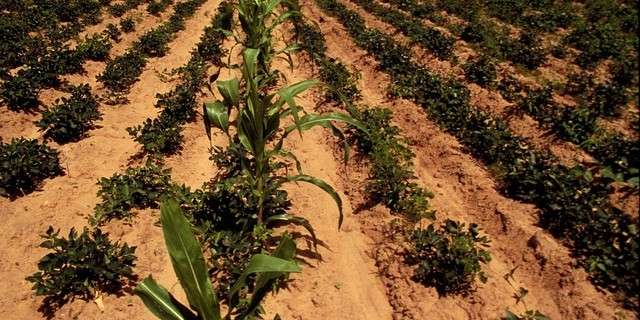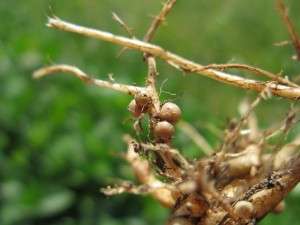Intercropping for ecological and economic efficiency in agriculture

Creating a sustainable agricultural system is one of the greatest concerns facing the world today. Human population growth, degraded lands, and stagnating productivity gains are combining to produce a global agricultural emergency. Past work has predicted that crop productivity will need to double to feed a growing population of 7 billion. The solution will likely come from a combination of sources: altered dietary habits, technological breakthroughs, and more sustainable and efficient use of currently cultivated lands.
In recent years, ecologists have focused more intensively on agricultural production methods that may use land more efficiently and more sustainably: namely the development of economically and ecologically efficient intercropping systems. Intercropping is the agricultural practice of growing multiple crops in the same field at the same time. Intercropping is sometimes complemented with double cropping, wherein a farmer may alternate cropping of different crops over time. Both practices can improve overall nutrient and light utilization of the system (due to niche complementarity) and increase pest control for crops (due to dilution effects of species-specific pathogens).
While intercropping can be a more intensive harvesting practice, it is an important and viable option in intensively farmed regions where the majority of farming relies on small subsistence-based or family farms.
Increased efficiency and implementation of intercropping systems will likely rely on increased optimization. Much of the research being done on the optimization of these systems is coming from China, where this style of agriculture is common: in the 1980's, intercropping accounted for up to 50% of Chinese cereal crop production, though that number is closer to 20% today (Huang 2015).
Recently, the Chinese government has begun encouraging research on and implementation of a "double high" agricultural standard: emphasizing both high yields and higher nutrient use efficiency. Over the past several years, work published in PLOS One has highlighted the great diversity of research being done on intercropping in China.
Yitao Zhang and colleagues (2015) recently published work on both (1) which species may most efficiently be used for intercropping and (2) the exact ratios that produce the most efficient outputs, both in terms of economic efficiency and yield. Much of the work on intercropping relies on the nitrogen fixing ability of plants in the legume family. Whereas all other species of plants need nitrogen supplied from the soil (usually in the form of industrially applied fertilizer), plants in the legume family have evolved a symbiosis with belowground rhizobia that allow them to "fix" nitrogen out of the nitrogen-rich atmosphere. Growing non-legume plants alongside legumes can reduce nitrogen-competition between species and enrich soil nitrogen reserves.

Zhang et al (2015) examined corn intercropped with either soybeans or red beans and found that both intercropping systems provided a benefit in terms of (1) yield advantage (nearly 1.3x the yield expected from monocultures), (2) economics, and (3) future yield potential of winter wheat (due to increased soil nitrogen accumulation in the legume intercropped soils).
In fact, intercropping increased corn yield by 42-92%!
The future of intercropping success and efficiency, however, likely lies in the details. The authors found that the most efficient intercropping ratio alternated between four rows of corn and six rows of soybean. This 4:6 intercropping system increased the economic benefit of the land by 26% over the corn monoculture – and this was after accounting for fertilizer costs, seed costs, machinery use, and labor.
Furthermore, work by Huang et al. (2015) highlights how the winter wheat – summer corn double cropping system is being augmented by some farmers with a watermelon intercrop. On an ad hoc basis, farmers in northern China have been exploring other styles of cash crops to increase their annual incomes. The authors found that the wheat-corn/watermelon intercropping system can decrease total yields of wheat and corn. However, the watermelon cash crop makes up for this with the added yield gain of watermelon plus the increased value of the watermelon crop.
Thus, the gross economic benefit to the small-scale farmer can increase average annual farm income from USD 2,534 to USD 3,883 – an increase of 54%.
Wang et al. (2014) explored how corn-faba bean, corn-soybean, corn-chickpea, and corn-turnip intercropping affect yield output and nutrient acquisition of agricultural fields in northwest China. The authors found that intercropping increased yields in almost all instances over their monoculture counterparts. Furthermore, the intercropping systems more efficiently removed nitrogen from the soils – indicating increased resource use efficiency in the intercropped systems. Nitrogen use efficiency is particularly important in northern China where environmental degradation due to fertilizer runoff has caused acidification of farmland and eutrophication of surface waters in the past.
Sun et a. (2014) explored the most efficient approaches to intercropping corn and alfalfa for forage. The ecological basis for intercropping success relies somewhat on the complementary strategies that different plant species employ for utilizing resources. A single species likely uses resources in one very specific way: when grown in monoculture that species may deplete its own resource base very rapidly and comprehensively. As such the authors explored different arrangements for growing corn in monoculture (alternating wide and narrow rows with evenly spaced rows) as well as intercropping these wide vs. narrow rows with rows of alfalfa. The authors found that the alternative pattern for growing corn in monoculture did increase corn monoculture yields – likely due to increased light interception and photosynthetic capacity. However, there was a yield advantage even above this for corn intercropped with alfalfa: the alfalfa intercropping system could increase total field yields by another ton per hectare.
Even more impressively, the alfalfa intercropping system increased economic benefits by up to USD 776 per hectare per year.
These intercropping benefits came from a combination of mechanisms, including facilitative effects of the alfalfa nitrogen fixation pathway as well as complementary resource capture over time. Alfalfa grows earlier in the season than corn, corn then outcompetes alfalfa in mid-summer, and alfalfa then also outlasts corn in the fall. The two species have complementary temporal niches.
Widespread implementation of intercropping systems will rely on our ability to increase the economic and ecological efficiency of these agricultural practices in a diversity of different countries and biomes. The work being done by a great number of scientists in China may be paving the way for greater adoption and economic feasibility of these options in the future. While the solution to global issues concerning food security and agriculture will certainly by multi-faceted, increasing the efficiency of lands must be one part of this solution. It's exciting to see such important research being done at the intersection of classic ecology and agricultural science.
More information: Adam S. Davis et al. Increasing Cropping System Diversity Balances Productivity, Profitability and Environmental Health, PLoS ONE (2012). DOI: 10.1371/journal.pone.0047149
Chengdong Huang et al. Economic Performance and Sustainability of a Novel Intercropping System on the North China Plain, PLOS ONE (2015). DOI: 10.1371/journal.pone.0135518 Chengdong
Huang et al. Economic Performance and Sustainability of a Novel Intercropping System on the North China Plain, PLOS ONE (2015). DOI: 10.1371/journal.pone.0135518
Baoru Sun et al. Alfalfa (Medicago sativa L.)/Maize (Zea mays L.) Intercropping Provides a Feasible Way to Improve Yield and Economic Incomes in Farming and Pastoral Areas of Northeast China, PLoS ONE (2014). DOI: 10.1371/journal.pone.0110556
Journal information: PLoS ONE
Provided by Public Library of Science
This story is republished courtesy of PLOS Blogs: blogs.plos.org.

















